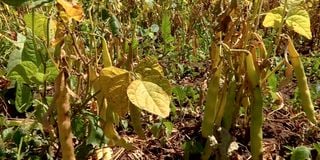High-iron and zinc bean variety boosts farmers’ livelihoods

A mature crop of Nyota bean at a farm in Subukia, Nakuru County. The variety requires minimal rainfall.
What you need to know:
- The red-mottled group bean stands out for its fast maturity and adaptability to varying climates, making it a valuable choice for farmers.
- Nyota, Swahili for "star," was developed by Karlo Katumani and released for national trials and commercialisation in 2017. It has proven to thrive in both hot dry regions and cold dry highlands, offering farmers versatility.
The Nyota bean variety, developed by the Kenya Agricultural and Livestock Research Organization (Karlo), is gaining rapid popularity among small-scale and subsistence farmers.
The red-mottled group bean stands out for its fast maturity and adaptability to varying climates, making it a valuable choice for farmers.
Nyota, Swahili for "star," was developed by Karlo Katumani and released for national trials and commercialisation in 2017. It has proven to thrive in both hot dry regions and cold dry highlands, offering farmers versatility.
Eunice Kanyigi, a farmer in Subukia, Nakuru County, attests to the positive impact of Nyota on her income and household nutrition.
“We started planting Nyota after Karlo trained us on its benefits such as high levels of zinc and iron,”she says.
“For those who have problems with flatulence after eating beans, Nyota doesn’t have that effect and it takes just an hour to boil. That saves me a lot of fire wood and cooking time.”
A kilo of Nyota beans retails at between Sh150 to Sh200
Head of the bean programme at Karlo David Karanja says they target small-scale and subsistence farmers to boost local bean production.
Despite annual bean production reaching 600,000 metric tonnes in Kenya, consumption is at 755,000 metric tonnes, leading to the need for imports. “A farmer with half an acre can produce six 90kg bags of beans. This way they will have something to eat and sell. In every village, farmers should collectively produce beans that can fill a 10-wheeled truck,” said Dr. Karanja.
Karlo aims to establish a bean corridor across the country, encouraging farmers with half an acre of land and above to participate.
The commercialisation of the Nyota bean variety is a significant accomplishment considering that out of 33 new bean varieties developed by Karlo and other institutions in the last decade, only eight have reached farmers. “Eight out of 33 new bean varieties have managed to get to the farmers. When a variety gets older than 10 years without being commercialised, it means we have lost public money and that is a concern for us,” added Dr Karanja.
According to coordinator of Seed Savers Network Kenya Daniel Wanjama, existing seed laws contribute to the loss of varieties developed by local researchers, favouring breeders over farmers.
Karlo estimates that bean consumption in the country will double this year, and the Nyota variety already meets the micronutrient levels of Zinc and Iron crucial for immunity and blood supply.
“It is unfortunate that researchers would work on a variety for 10 years, getting paid by the exchequer to ensure we have better yielding seeds and at the end of research, the variety registered fails to reach the farmers who are the intended beneficiaries,” said Mr Wanjama.
A 2022 report by the Kenya National Bureau of Statistics reveals nutritional challenges, with 18 per cent of children under the age of five experiencing stunted growth and 42 per cent of pregnant women suffering from aanemia. To ensure consistent supply, Karlo is exploring the creation of a bean value chain, allowing farmers to supply processors who can combine bean powder into consumable products like noodles.
“We are encouraging farmers to grow flatulence-free beans and then we will have a healthy nation,” adds Dr Karanja.
The successful commercialisation of the Nyota bean variety is a collaborative effort between Karlo, International Center for Tropical Agriculture and Seed Equal with support from the Canadian and Australian governments and the Bill and Melinda Gates Foundation.



